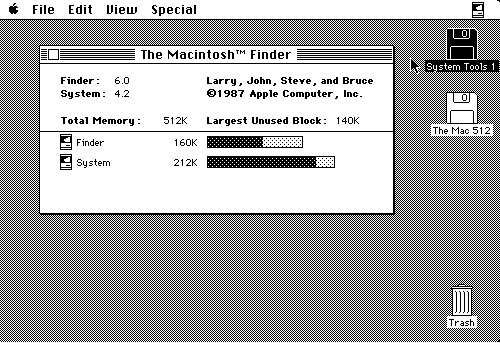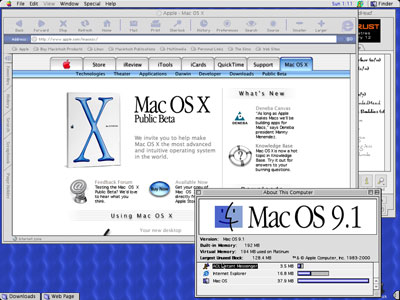Mac OS History
By: Mike Yocom - Revised: 2006-06-01 devinIntroduction
The Mac OS was not the first graphical user interface, but it was the first successful one. The reason for this is simple: affordability. The Xerox Alto cost $32 000 to build, the Xerox Star retailed for $16 600, and the Apple Lisa retailed for $10 000. The first Macintosh, on the other hand, retailed for $2 500. Because it was affordable by average people, it was immediately much more attractive than the GUI computers that came before it.Section Links
Note: Version numbers used are the OS versions, rather than the Finder versions or the Macintosh System Software versions.
System 1 had a desktop, windows, icons, a mouse, menus, and scrollbars. Disks had an "Empty Folder" — new folders were created by changing the name of the Empty Folder — a replacement Empty Folder would immediately appear. The Trash worked like a garbage chute — anything in it would disappear with the next restart. Only one program could be run at a time, no virtual memory or protected memory was available. Some of the standard Macintosh features were missing — AppleTalk, desktop pictures, color, QuickTime, even Zoom Boxes. It was also impossible to nest folders within folders — in fact, folders were illusionary, all files were stored on the root level of a disk, with a note in the file table for which files were in which folder so the Finder could make them appear to be in the appropriate folder.
System 1.1 added the About dialog box, the Clean Up command, and some speed improvements.

System 2 was notable by making the Finder twenty percent faster. The Put Back and Close All commands were eliminated, while New Folder and Shutdown were added. Disks could now be ejected by dragging their icons to the Trash, instead of selecting the Eject Disk command and then dragging the icon to the Trash. A non-hierarchical List View, where items within a folder were listed in a vertical list with small icons, was added. A Choose Printer desk accessory was added, this would eventually evolve into the Chooser.

System 3 improved Finder speed even more. Hierarchical File System (HFS) replaced the Macintosh File System (MFS) of Systems 1 and 2 — folders were now real, and folders could be nested within folders. Zoom boxes were added to the right end of window title bars — clicking would make the window resize to just fit the contents of that folder, if possible — clicking again would make the window go back to its old size. The Trash icon bulged when something was put in it, and the lines pointed the opposite direction. (Like ")" instead of "(".)
System 3.1 was horrendously buggy.
System 3.2 fixed thirty bugs. The Calculator was updated so that the onscreen keypad looked like the keypad on keyboards.
System 3.3 was enhanced for AppleShare, the old Macintosh file sharing.

System 4 was introduced with the Macintosh SE and Macintosh II. System 4 added multiple monitor support.
System 4.1 added support for disk drives of 32+ MB.

System 4.2 implemented MultiFinder — users could switch between Finder, which only supported one program at a time, and MultiFinder, which could support multiple programs. "About the Finder" now showed how much memory each program was using. A customizable Control Panel program was also included.
System 4.3 was a service upgrade — bug fixes and some updated printer drivers.

System 6 added color support, although the Finder itself still didn't use color, even on color-capable machines. Erase Disk was enhanced with a progress dialog with a Cancel button. Get Info was enhanced to show the version number of a file. Notification Monitor allowed programs to notify users through the menu bar if they needed input.
Systems 6.0.1—6.0.8 simply added support for new models as they were released.

System 7 was the biggest change to the system software to that time. System 7 eliminated the Finder/MultiFinder issue — System 7's Finder is MultiFinder — turning multitasking on for good. Memory management also got an overhaul: 32b memory addressing — which allows Macs to use more than 8 MB of RAM — was integrated into the operating system, Virtual Memory — which uses an unused section of hard drive space as substitute memory — was also first implemented in System 7. Networking via AppleTalk and file sharing via AppleShare were built into the operating system, instead of being optional. QuickTime multimedia software also debuted at this time — but was available separately.
A menu was added to the right end of the Menu Bar — the Application Menu, which showed a list of running programs and allowed users to switch between them. Next to the Application Menu was the Help Menu. The Trash was changed into a true folder, meaning that items put in it remained until the Empty Trash command was selected. Aliases — later copied by Windows as Shortcuts — first appeared in System 7. Drag and Drop — where a selected section of text could just be dragged from one program to the other instead of having to copy and paste — was implemented. System 7's Finder finally took advantage of color monitors — making some interface elements look a little three-dimensional.
System 7.x also had the largest number of minor updates.
System 7.0.1 fixed a few bugs. System 7.0.1p was a Performa-specific release with System 7.0.1's fixes, plus some special features for novice users. (Performa was the name of Apple's home computer line for a number of years.)
System 7.1 implemented the Fonts folder so that fonts could be easily added and removed — previously they were buried within the System itself — and the Enabler scheme — which mean new models could be released with an Enabler file instead of a very minor update like with Systems 6.0.1—6.0.8. There was also a System 7.1p for Performas.
System 7.1.1 — also known as System 7 Pro — bundled AppleScript, QuickTime, and PowerTalk, all of which used to be available separately. System 7.1.2 was made to support the PowerPC chip. System 7.1.3 fixed bugs in System 7.1.2.
System 7.5 integrated all of the features from the Performa releases. It also added the much more helpful Apple Guide help system. The startup screen finally had a progress bar.
Despite how far the Mac had come in the eleven years leading up to System 7.5, it was becoming clear that the Mac needed an entirely rewritten operating system. See the "Need for a New OS" section for details.
System 7.5.1 fixed bugs and the Mac OS Logo at startup. System 7.5.2 was available in two, incompatible versions: one for the first PCI Power Macs, one for the portables released at about the same time. System 7.5.3 incorporated some much-needed bug fixes.
Then things get really confusing. System 7.5.3L supported the first Mac Clones. System 7.5.3 Revisions 2, 2.1, and 2.2 were all bug fixes and supported new models. (Why no Enablers?) System 7.5.4 was announced, but not released because of a last-minute discovery of some major bugs. System 7.5.5 combined all the 7.5.3 versions and fixed more bugs.
Mac OS 7.6 was the first release following Apple's strategy of releasing an update for the then-current Mac OS every six months until Rhapsody/Mac OS X could be completed. It was updated with some bug fixes via Mac OS 7.6.1.

Mac OS 8 revamped the Finder. The Finder was finally multithreaded — meaning that it could do more than one thing at the same time. Multithreading also meant that computers with more than one processor would experience better Finder performance. The overall appearance of the Finder was revamped to look more three-dimensional. The appearance of the Finder was also made a lot more customizable. Personal Web Sharing allowed users to host web pages on their computers.
Mac OS 8.1 was most notable for HFS+. This improved version of the Hierarchical File System introduced with System 3 freed up lots of space — hundreds of megabytes — on hard drives larger than 1 GB. (It does this by dividing the drive into a larger number of sectors, meaning that the minimum file size is much smaller, and there's less space wasted by small files.) Mac OS 8.1 was also the last version to support 68K Macs, all subsequent versions were PowerPC-only. [Thanks to Jeff Leadbeater for bringing that to our attention. — mpy]
Mac OS 8.5 introduced Sherlock, an extremely advanced search program that works on local drives, network servers, and the Internet. Mac OS 8.5.1 was a maintenance update. Mac OS 8.6 added a Find by Content option to Sherlock, enhanced power management, and improved USB and FireWire support.

Multiple Users was added in Mac OS 9, which allowed users to log in and have their own, unique settings. AppleTalk over TCP/IP was also implemented. Software Update allowed users to get updates to software off the internet, and would inform users of new updates as they came out.
Mac OS 9.0.2 and 9.0.3 shipped with specific models. Mac OS 9.0.4 unified everything again, and is the only version of the classic Mac OS compatible with the Classic environment in Mac OS X Public Beta.
Mac OS 9.1 improved stability and added the Window menu. It is the minimum for the Classic Environment in Mac OS X 10.0 and 10.1. Mac OS 9.2 was only available as a pre-installed system starting with the "Quicksilver" Power Mac G4s released in the summer of 2001. Mac OS 9.2.1 was released soon after as a maintenance update, and is recommended for Classic in Mac OS X 10.1. Mac OS 9.2.2, the final version, was released near the end of 2001, and improves Classic performance.
- Documentation
- Administration
- Authentication
- General Software
- Hardware
- Miscellaneous
- Multimedia
- Networking
- Operating Systems
- Outside Presentations
- Programming & Scripting
- Security
- Servers
- Short Courses
- System Deployment
- System Utilities
- What's New

